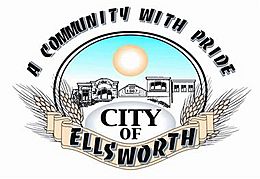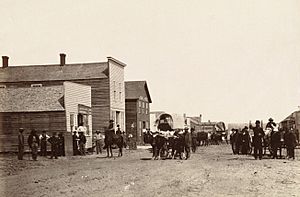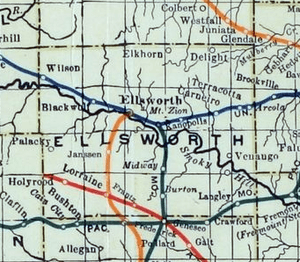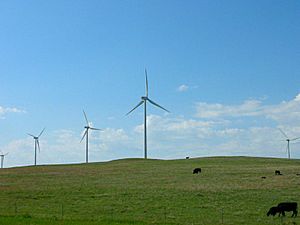Ellsworth, Kansas facts for kids
Quick facts for kids
Ellsworth, Kansas
|
||
|---|---|---|
|
City and County seat
|
||
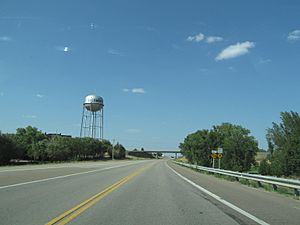
Ellsworth water tower as seen from Kansas State Highway 156 (2012)
|
||
|
||
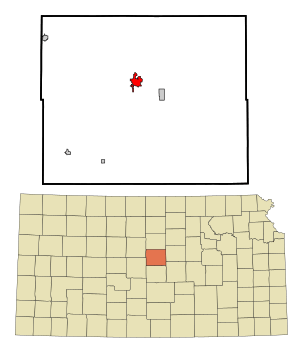
|
||
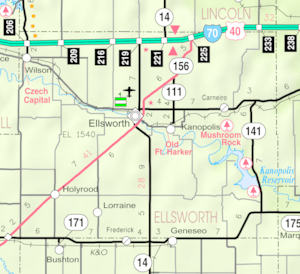
|
||
| Country | United States | |
| State | Kansas | |
| County | Ellsworth | |
| Founded | 1860s | |
| Incorporated | 1867 | |
| Named for | Fort Ellsworth | |
| Government | ||
| • Type | Mayor–Council | |
| Area | ||
| • Total | 2.39 sq mi (6.20 km2) | |
| • Land | 2.39 sq mi (6.20 km2) | |
| • Water | 0.00 sq mi (0.00 km2) | |
| Elevation | 1,545 ft (471 m) | |
| Population
(2020)
|
||
| • Total | 3,066 | |
| • Density | 1,282.8/sq mi (494.5/km2) | |
| Time zone | UTC-6 (CST) | |
| • Summer (DST) | UTC-5 (CDT) | |
| ZIP code |
67439
|
|
| Area code | 785 | |
| FIPS code | 20-20500 | |
| GNIS ID | 485570 | |
Ellsworth is a city in Ellsworth County, Kansas, United States. It is also the county seat, which means it's where the main government offices for the county are located. In 2020, about 3,066 people lived there.
In the 1870s, Ellsworth was known as a "cow town." This was because the Kansas Pacific Railroad had a special area where cattle were kept before being shipped to markets in the eastern United States. Today, Ellsworth is an important trading center for the farms and towns around it.
Contents
History of Ellsworth
Ellsworth in the 1800s
Ellsworth is named after Fort Ellsworth, a fort built in 1864. The city grew very quickly, reaching over 2,000 people by 1867. This was because people expected a railroad to be built there soon. Ellsworth was once called "The Wickedest Cattletown in Kansas" because of all the activity and sometimes trouble that happened there.
For a while in the late 1860s, Ellsworth was a busy place for cattle. Cowboys would bring cattle all the way from Texas to Ellsworth. From there, the cattle were loaded onto trains by the Kansas Pacific Railway and sent to big cities. Cowboys often caused trouble in town. By the mid-1880s, the cattle business in Ellsworth had almost stopped.
Ellsworth was known for being a wild cattle town in the late 1860s and 1870s. There were many arguments and fights, especially among cowboys. In 1868, Wild Bill Hickok ran for sheriff of Ellsworth County but lost. The new sheriff, E. W. Kingsbury, was good at his job, but he relied on local marshals to keep order in town.
Violence was common among cowboys and others. In 1869, Ellsworth marshal Will Semans was shot and killed while trying to calm down a rowdy man in a dance hall. After this, two small-time criminals, Craig and Johnson, caused trouble and stole things. Citizens formed a group to catch them. Chauncey Whitney became a deputy and was known for being tough and respected. In 1872, a large hotel called the Drovers Cottage was built. It could host 175 guests and stable many horses and carriages, showing how much business there was.
The famous lawman Wyatt Earp worked in Ellsworth for a short time. He later said he arrested Ben Thompson there. However, Thompson was actually arrested by Deputy Ed Hogue. This happened after Ben's brother, Billy Thompson, accidentally shot and killed Sheriff Chauncey Whitney in 1873. Billy Thompson ran away because he feared he would be harmed by an angry crowd. He was later caught and put on trial, but he was found not guilty. Sheriff Whitney, who was friends with both Thompson brothers, had said before he died that the shooting was an accident.
By the late 1870s, crime in Ellsworth had gone down a lot. Fewer cowboys came through because the Kansas Pacific Railroad moved its cattle pens to other cities like Dodge City and Abilene, Kansas. This caused Ellsworth to face economic challenges.
Ellsworth in the 2000s
Today, Ellsworth is working to attract visitors who are interested in its unique history. There are plans to restore the Signature Insurance Building to become the National Drovers Hall of Fame, a museum about cattle drivers. Money for this project is being raised partly through a yearly cattle drive parade down Main Street and Douglas Avenue. This is one of the few historically accurate cattle drives in the United States.
Geography of Ellsworth
Ellsworth is located at 38°43′55″N 98°13′45″W / 38.73194°N 98.22917°W. It is about 1,539 feet (469 meters) above sea level. The city is on the north side of the Smoky Hill River in the Smoky Hills area of the Great Plains. Oak Creek, a smaller stream, flows south past the eastern part of the city and joins the Smoky Hill River.
Ellsworth is in central Kansas, where highways K-14, K-140, and K-156 meet. It is about 27 miles (43 km) west-southwest of Salina, Kansas. Ellsworth is also about 82 miles (132 km) northwest of Wichita and 192 miles (309 km) west-southwest of Kansas City. The city covers an area of about 2.43 square miles (6.29 square kilometers), all of which is land.
Climate
Ellsworth has hot, humid summers and cold, dry winters. The average temperature is 53°F (12°C). The city gets about 27.3 inches (694 mm) of rain each year and about 16.7 inches (424 mm) of snow. July is usually the warmest month, and January is the coldest. May is the wettest month. The highest temperature ever recorded in Ellsworth was 117°F (47°C) in 1936, and the lowest was -30°F (-34°C) in 1913.
| Climate data for Ellsworth, Kansas | |||||||||||||
|---|---|---|---|---|---|---|---|---|---|---|---|---|---|
| Month | Jan | Feb | Mar | Apr | May | Jun | Jul | Aug | Sep | Oct | Nov | Dec | Year |
| Record high °F (°C) | 78 (26) |
89 (32) |
98 (37) |
101 (38) |
108 (42) |
115 (46) |
116 (47) |
117 (47) |
114 (46) |
102 (39) |
88 (31) |
80 (27) |
117 (47) |
| Mean daily maximum °F (°C) | 39 (4) |
46 (8) |
55 (13) |
66 (19) |
75 (24) |
86 (30) |
92 (33) |
89 (32) |
81 (27) |
70 (21) |
53 (12) |
42 (6) |
66 (19) |
| Mean daily minimum °F (°C) | 13 (−11) |
18 (−8) |
28 (−2) |
39 (4) |
51 (11) |
61 (16) |
67 (19) |
64 (18) |
54 (12) |
41 (5) |
27 (−3) |
17 (−8) |
40 (4) |
| Record low °F (°C) | −30 (−34) |
−28 (−33) |
−16 (−27) |
7 (−14) |
17 (−8) |
40 (4) |
43 (6) |
40 (4) |
24 (−4) |
8 (−13) |
−7 (−22) |
−28 (−33) |
−30 (−34) |
| Average precipitation inches (mm) | 0.72 (18) |
0.86 (22) |
2.46 (62) |
2.49 (63) |
5.11 (130) |
3.46 (88) |
3.58 (91) |
3.36 (85) |
2.61 (66) |
2.31 (59) |
1.25 (32) |
0.80 (20) |
29.01 (736) |
| Average snowfall inches (cm) | 6.3 (16) |
3.3 (8.4) |
1.9 (4.8) |
0.4 (1.0) |
0 (0) |
0 (0) |
0 (0) |
0 (0) |
0 (0) |
0.2 (0.51) |
1.1 (2.8) |
3.4 (8.6) |
16.6 (42.11) |
| Source: The Weather Channel; National Weather Service | |||||||||||||
Population of Ellsworth
| Historical population | |||
|---|---|---|---|
| Census | Pop. | %± | |
| 1870 | 448 | — | |
| 1880 | 929 | 107.4% | |
| 1890 | 1,620 | 74.4% | |
| 1900 | 1,549 | −4.4% | |
| 1910 | 2,041 | 31.8% | |
| 1920 | 2,065 | 1.2% | |
| 1930 | 2,072 | 0.3% | |
| 1940 | 2,227 | 7.5% | |
| 1950 | 2,193 | −1.5% | |
| 1960 | 2,361 | 7.7% | |
| 1970 | 2,080 | −11.9% | |
| 1980 | 2,465 | 18.5% | |
| 1990 | 2,294 | −6.9% | |
| 2000 | 2,965 | 29.3% | |
| 2010 | 3,120 | 5.2% | |
| 2020 | 3,066 | −1.7% | |
| U.S. Decennial Census | |||
2020 Census Information
In 2020, Ellsworth had a population of 3,066 people. There were 969 households and 551 families living in the city. About 16% of the population was under 18 years old. The median age in Ellsworth was 40 years.
Education in Ellsworth
The public schools in Ellsworth are part of the Ellsworth USD 327 school district. The high school, Ellsworth Jr/Sr High School, is located in Ellsworth. The school's mascot is the Ellsworth Bearcats.
Media in Ellsworth
Ellsworth has its own weekly newspaper called the Ellsworth County Independent/Reporter. There is also a radio station translator, K243AR, which broadcasts on 96.5 FM. It plays Christian music and is a translator for KRSL radio station in Russell, Kansas.
Infrastructure and Energy
In 2008, two companies, TradeWind Energy and Enel North America, built the Smoky Hills Wind Farm in Ellsworth and Lincoln counties. This wind farm has 155 wind turbines that can produce a lot of electricity, enough to power about 85,000 homes. The turbines are located on about 20,000 acres of farmland, and many landowners have agreements to have the turbines on their property.
Another wind power project, the Post Rock Wind Farm, was completed in 2012. It also spans Ellsworth and Lincoln counties and has 134 wind turbines. This facility covers about 23,000 acres and helps provide electricity to the area.
Notable People from Ellsworth
- Keith L. Ackerman, an Episcopal bishop
- Kaden Davis, an NFL player
- Kelvin Droegemeier, a professor and meteorologist who was a Science Advisor to the President
- Wyatt Earp, a famous lawman
- Robert Herbert Mize, Jr., an Anglican bishop
- John Morco, a gunfighter
- Ben Thompson, a gunfighter
- Billy Thompson, a gunfighter
See also
 In Spanish: Ellsworth (Kansas) para niños
In Spanish: Ellsworth (Kansas) para niños


